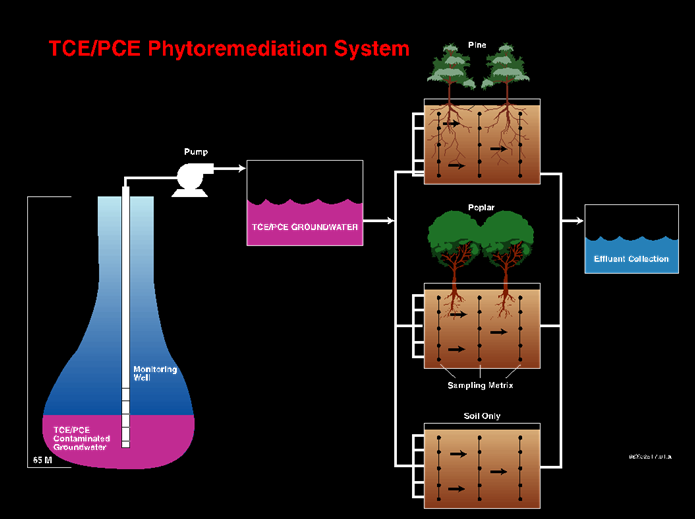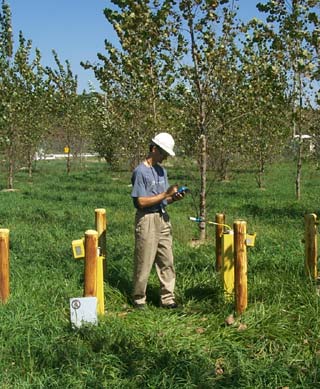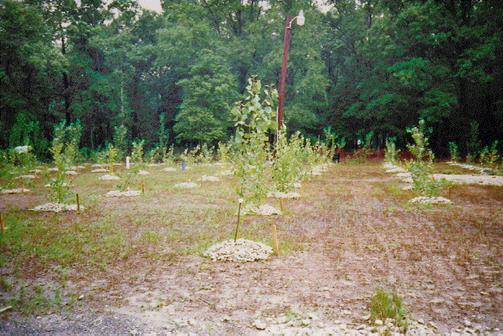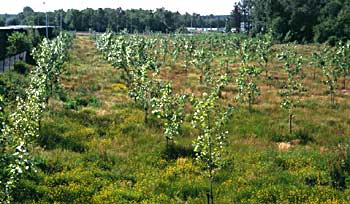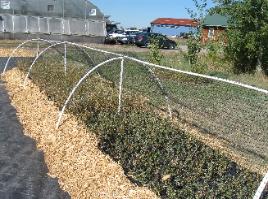

| Case studies | ||
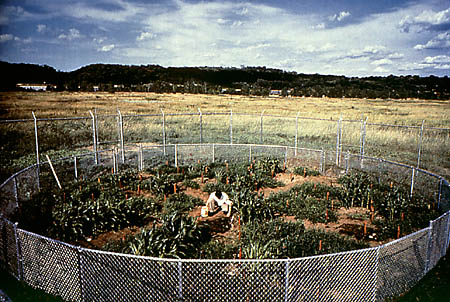 |
||
| Revival Field, 1990-1993 Pig’s Eye Landfill, Saint Paul, Minnesota | ||
Revival Fields At the time of the construction it was actually illegal for anyone to be on the site because the toxin levels were so high. For three years the project team dug up and replanted the plants hoping to diminish the toxic levels. The plants were analyzed for metal content stored in the cellular structure. “Chaney calculated that pennycress could absorb the metal at an annual rate of 125 kilograms per hectare if the soil was acidified to a pH of 5 or 6. So a typical contaminated site might take 16 years to clean. Chaney believes that with the right strain of pennycress, or some genetic tinkering, this could be reduced to four years.” (New Scientist, 1997, home.earthlink.net/~adamsamy/PDFs/Thousand_flowers.pdf The success of this site led to a second project in Palmerton,
Pennsylvania, on a site heavily contaminated by similar pollutants
from a zinc smelting plant. Chin designed a fan-shaped garden which
he let grow for three full years. Chin found that uptake and absorption
of zinc and cadmium actually increased during each successional
year that the plant grew. |
||
Stormwater run-off pollution control the problem |
||
Tacony – a new urban riverfront neighborhood
The Fosterville Gold Mine, near Bendigo, Victoria, Australia The Aria serpentine quarry, Waikato district, North Island New Zealan
Mount Te Aroha in the Coromandel district of the North Island of New Zealand site type
Endophyte-assisted phytoremediation TNT and Exposives: Researchers: Elizabeth Rylott, Maria Budarina, Ann Barker, Astrid Lorenz, Stuart Strand, and Neil Bruce The problem: RDX and TNT contamination on military training ranges. RDX is taken up and degraded more easily than TNT but the phytotoxicity of TNT kills a plant before it can degrade RDX. The solution: Arabidopsis thaliana has been genetically modified with a few bacterial genes that encourage the uptake and degredation of RDX while tolerating TNT. The genetic modification was successful; the transgenic plants can withstand levels of TNT that other plants cannot. They also take up TNT more quickly, and therefore RDX more quickly, than a natural plant. It was found, however, that a plant will not uptake RDX until TNT is below a certain concentration. The drawback to this study is that Arabidopsis thaliana is a small sidewalk-crack plant whose root system is much too shallow to work for phytoremediation. It is most likely that a similar project on a more deeply-rooted plant like rye grass would be more successful in the field. This study does demonstrate that it is more effective to combine the bacteria with the plants than simply inoculating the soil with the bacteria. There is a beneficial relationship for the bacteria and the plant.
TCE: Researchers: Nele Weyens, Daniel van der Lelie, Tom Artois, Karen Smeets, Safiyh Taghavi, Lee Newman, Robert Carleer, and Jacob Vangronsveld The problem: Introducing endphytic bacteria to a plant to reduce the amount of evapotranspiration of a plant, thereby reducing the amount of TCE released into the atmosphere The solution: Under lab conditions, endophytes helped reduce the amount of evapotranspiration, but a field test is required to truly test efficacy. Poplar trees were innoculated with two endophytes: one that degraded TCE and one that reduced evapotranspiration. This on-site test was successful in reducing the amount of transpiration from the trees. The researchers introduced an endophyte to the tree. The study became successful when the bacteria established itself as a poplar root endophyte and began sharing its TCE degrading genetic material with different bacteria populations through horizontal gene transfer. Because the altered endophytes were created through horizontal gene transfer, its release does not fall under European classifications of geneticaly modified organisms (GMOs). This is important because development of GMOs makes many people nervous about what transgenic plants will do once they’re in the field. One issue with this experiment is that they did not measure the uptake in the soil so the experiment never tested to see if the site itself was actually remediated. With some toxins, endophyte-assisted remediation is actually more effective than transgenic phytoremediation. In this experiment especially, it was important to research reducing evapotranspiration because a major concern about phytoremediation is the release of volatile contaminates into the atmosphere. This study also successfuly introduced a bacterial strain that was altered under lab conditions back into the environment.
Cleanup of VOCs in Oregon with Poplars The problem: the site was contaminated with volatile organic compounds (VOCs). The solution: Hybrid poplar trees were planted on the site in hopes that their roots would reach the contaminated ground water. When the soil and water at the site were tested there was no conclusive proof that the trees were really effective at uptake, but when tissue samples from some of the trees were tested, contaminates were found. The highest concentration of VOCs was found in the trunk of the tree. In 2002 when the tests were run the trees were flourishing despite the contamination. This site was planted in 1998 and it shows that unmodified poplar trees are effective at uptake of VOCs. With where technology is today, however, uptake could be much more effective if the mechanism that the poplar is using to uptake the VOCs is enhanced. Endophyte-assisted remediation or genetically modifying the poplar trees may be the solution to achieving cleanup more quickly and more effectively.
J-Field at Aberdeen Proving Ground The problem: because of dumping from 1940 through the 1970s there were many chemicals in the groundwater, but primarily TCE was the concern. The solution: 183 hybrid poplar trees were planted on a contaminated acre to test if phytoremedation of TCE and other VOCs on the site were treatable through phytoremedation. Testing on the site shows that the poplars are removing the VOCs from the environment and evapotranspiring them into the atmosphere. The estimate is that within 30 years of planting, the trees will remove up to 85% of the contamination on the site.
Atrazine: The problem: Finding a plant that can degrade atrazine and has agricultural benefits The solution: Test Lolium multiflorum (rye grass) to see what mechanism the grass uses to degrade and tolerate atrazine so that gene can be enhanced. L. multiflorum already had a natural tolerance for atrazine, but this study examined what in the grass was giving the plant its tolerance. The experiment looked at whether the mechanism was genetic, enzymatic, or non-enzymatic in nature. The results show that the tolerance comes from enhanced enzymatic detoxification from P450. What is important to take away from this study, however, is that L. multiflorum fits the problem well. Not only does it grow in toxic conditions in which many plants would not survive, but it also naturally degrades atrazine. The plant even has a high initial degradation rate which can help prevent atrazine-contaminated runoff. L. multiflorum is also a crop feasibly interplanted with other crops, and so it has an economic benefit as well. Poplars are another plant that can degrade atrazine, but they cannot be planted among crops. However, poplars are often planted along riparian corridors to prevent the contaminant from getting into the water.
BTEX: Researchers: Barac, Weyens, Oeyen, Taghavi, van der Lelie, Dubin, Spliet, and Vangronsveld The problem: Years of leakage from underground storage tanks let BTEX leech into a groundwater plume. The contaminates were reaching past the boundaries of Ford’s property. The solution: After the storage tanks were removed and placed above ground, 275 poplar trees were planted on the site to contain the BTEX plume. For the first 13 months the trees had not reached maturity and their roots had not been able to reach the groundwater plume. After 42 months the roots reached the plume and the uptake into the trees was such that the plume was contained behind the line of planting but the concentration of BTEX was not any less. After 50 months the plume was still contained and the concentration of BTEX in the plume behind the poplars was decreased; the core of the plume was not affected, however. At 55 months, during the growing season, the uptake from the poplars was such that all of the BTEX in the plume was taken up. When tested in the lab, it was found that the plant itself was not degrading the BTEX, but the rhizosphere bacteria and the endophytes were. The study also shows that once the poplar roots reached the BTEX plume there was enrichment of the rhizosphere and endophytic bacteria that degraded tolulene. Conversely, once the concentration of BTEX dropped after remediation, the number of bacteria in the rhizosphere and the endophytic bacteria that degraded tolulene dropped below detection. This suggests that the bacteria populations benefited from the presence of the BTEX by using it as an energy source. This study is important because it is one of a handful of published field tests. Many phytoremediation sites are not published (whether successful or not) because companies want to keep the fact that they had a contamination issue quiet.
PAHs: The problem: PAHs with low molecular weight, like naphthalene, are phytotoxic to plants typically used to phytoremediate other PAHs. The solution: Create a naphthalene-degrading strain of endophytic bacteria and test its efficacy on pea plants. This endophytic strain successfully colonized both the rhizosphere and root tissues of the plant, and the endophyte successfully protected the plant from the effects of naphthalene. The endophytic strain helped degrade the naphthalene in the soil without a plant, but partnered with a plant performed much better. This clearly demonstrates that endophytes help significantly in the phytoremediation of a site. Endophytes also help plants be healthier, so when they can use a toxin as an energy source, everyone wins. There is some discussion of whether PAHs with higher molecular weight are more toxic, or whether PAHs with low molecular weight are more toxic. Regardless of which side is right, this paper demonstrates the fact that endophytes combined with plants are much more effective. The soil can be inoculated with just bacteria, but paired with plants the roots are able to penetrate much deeper into the soil and distribute the endophytes more effectively.
Mercury: Researchers: Centre for Environment and Marine Studies, Department of Biology, University of Aveiro The problem: Mercury contaminated sediments resulting from historical contamination are still cause for concern due to their potential release into other environmental matrices. Thus, due to the deleterious effects of mercury on ecosystem functions and human health, the assessment of mercury contamination continues to be of The solution: Juncus maritimus and Scirpus maritimus are both species that live in basins and lagoons that have natural mercury contamination. Although both plants are capable of sequestration of Hg, J. maritimus has a capacity per square meter 4-5 times higher than S. maritimus. In conclusion, J. maritimus seems to provide a comparatively higher ecosystem service through phytostabilization.
Arsenic: The problem: Arsenic (As) accumulation in food crops such as rice is of major concern The solution: Implementation of Pteris vittata, a well-known As hyper-accumulator possess an exceptional Although the present study has demonstrated a large effect of phytoremediation on decreasing As uptake by rice, it should be borne in mind that the experiment was performed in pots under glasshouse conditions. Field trials are needed to confirm if phytoremediation can be similarly effective under local rice growing conditions. Another issue to consider is whether the effect is long lasting because of the possibility of a re-distribution of As to the bioavailable pool following phytoremediation. A further constraint is whether farmers can afford to set aside their land for phytoremediation.
Heavy Metals-Selenium: The problem: For animals, there is a narrow window between the amount of Selenium (Se) required as a nutrient and the amount that is toxic; as a consequence, both Se deficiency and toxicity are common problems worldwide. Plants may help alleviate both of these problems, either as a source of dietary Se or for phytoremediation of excess Se from the environment. Selenium-enriched diets have been shown to prevent different forms of cancer, viral infections including HIV, and male infertility. Plants have also been shown to be able to clean up agricultural and industrial wastewaters and soils, owing to their capacity to not only take up and accumulate Se but also convert inorganic Se into volatile forms that are released into the atmosphere. The solution: ATP sulfurylase (APS) from Arabidopsis thaliana was constitutively expressed in Brassica juncea (Indian mustard). The resulting APS transgenics accumulated an organic form of Se. e APS plants accumulated twofold–threefold more Se than the wild type. Perhaps because of their enhanced Se assimilation, the APS transgenics tolerated the accumulated Se better than the wild type. Selenium volatilization rate was unaltered in the APS transgenics. From these studies, it can be concluded that ATP sulfurylase is involved in selenate reduction and is rate limiting for the assimilation of selenate to organic Se. The enhanced APS expression also appears to trigger selenate uptake and Se accumulation. The cystathionine gamma synthas (CgS) transgenics of Arabidopsis thaliana and Brassica juncea accumulated 40% less Se in their tissues than the wild type, probably as a result of their enhanced volatilization. The CgS plants were also more tolerant than wild-type plants, perhaps because of their lower tissue Se levels. On the basis of these results, it can be concluded that CgS is involved in and rate limiting for Se volatilization. Results obtained from the different transgenics under controlled laboratory conditions were essentially the same as those obtained when using naturally seleniferous or Se-contaminated soils in greenhouse or field. The various transgenics showed enhanced Se accumulation, volatilization, and/or tolerance, all promising traits for use as Se-fortified foods or for phytoremediation.
Excess Nutrients: The problem: Increasing use of fertilizer results in significant buildup of nutrients, such as nitrogen (N) and phosphorus (P), in the soils. When the soils are saturated, these nutrients are subjected to losses by leaching and surface runoff. Water quality is impaired and water availability is reduced because of accelerated eutrophication the solution: Use of Pistia stratiotes L. (water Lettuce) show that total suspended solids in the water column were decreased by an average of approximately 10% in the treatment plots as compared with those in the control plots due to sedimentation in a more favorable environment provided by the plants. On average, water turbidity was reduced by 65.5% and 63.3% in treatment plots, as compared with the controls in East and West Ponds, respectively, in the period from August 2005 to August 2007. Water lettuce growth decreased water EC in both ponds, due to salt removal from the waters by plant uptake or root adsorption. In a similar trend, water lettuce growth decreased water pH, which was not expected for it is well known that water pH rises with plant photosynthesis. Phytoremediation can be an important approach for cleaning eutrophicated stormwaters from agriculture and urban areas via man-made wetlands such as STAs and water detention/retention systems. Water lettuce has a great potential for removing N and P, reducing water suspended solids and turbidity from stormwaters, and improving water quality.
Using Sunflowers to Decontaminate Water Affected by Chernobyl The problem: Water around the site has been contaminated by radionucleides The solution: Phytotech planted sunflowers in rafts and floated them in the pond. The sunflowers specifically target cesium 137 and strontium 90 amonst the other contaminates in the pond. The sunflowers work very quickly; it is estimated that most of the contamination in the 75 square kilometer pond would have been taken up within just a few weeks. Once the water is decontaminated the work is undone if contaminates leach in again, so Phytotech also planted the shores around the pond with Brassica juncea to remove contaminates from the soil around the pond.
Using Sunflowers to Decontaminate Soil in Japen The problem: soil around the nuclear plant is contaminated with cesium The solution: Planting sunflowers on the site will result in them taking up the cesium because it is similar to a fertilizer that sunflowers like. Sunflowers have been proven before at sites like Chernobyl and in other studies to take up cesium efficiently. To avoid having to store the biomass once the sunflowers are harvested from the site there are plans to burn the sunflowers. There are also discussions of using bacteria to decompose the sunflowers to a fraction of their original biomass, leaving less radioactive material to be stored. This is a quick, relatively inexpensive way of cleaning up a very contaminated area. There are proposals to involve the community in planting the seeds which provides a rare opportunity for the people most directly affected by the contamination to help clean it up.
|
||
